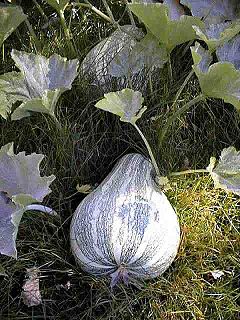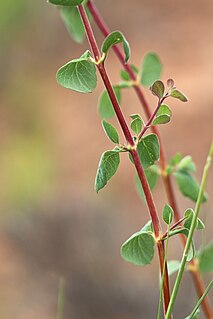
Cucurbita is a genus of herbaceous vines in the gourd family, Cucurbitaceae native to the Andes and Mesoamerica. Five species are grown worldwide for their edible fruit, variously known as squash, pumpkin, or gourd, depending on species, variety, and local parlance, and for their seeds. Other kinds of gourd, also called bottle-gourds, are native to Africa and belong to the genus Lagenaria, which is in the same family and subfamily as Cucurbita, but in a different tribe. These other gourds are used as utensils or vessels, and their young fruits are eaten much like those of Cucurbita species.

Cucurbita pepo is a cultivated plant of the genus Cucurbita. It yields varieties of winter squash and pumpkin, but the most widespread varieties belong to the subspecies Cucurbita pepo subsp. pepo, called summer squash.

Cucurbita ficifolia is a species of squash, grown for its edible seeds, fruit, and greens. It has many common names in English such as the fig-leaf gourd, Malabar gourd, black seed squash and cidra. Although it is closely related to other squashes in its genus, such as the pumpkin, it shows considerable biochemical difference from them and does not hybridize readily with them.

Phacelia crenulata is a species of flowering plant in the borage family, Boraginaceae. Its common names include notch-leaf scorpion-weed, notch-leaved phacelia, cleftleaf wildheliotrope, and heliotrope phacelia. It is native to the southwestern United States as far east as Colorado and New Mexico, and Baja California and Sonora in Mexico.

Cucurbita foetidissima is a tuberous xerophytic plant found in the central and southwestern United States and northern Mexico. It has numerous common names, including: buffalo gourd, calabazilla, chilicote, coyote gourd, fetid gourd, fetid wild pumpkin, Missouri gourd, prairie gourd, stinking gourd, wild gourd, and wild pumpkin. The type specimen was collected from Mexico by Alexander von Humboldt and Aimé Bonpland sometime before 1817.

Cucurbita palmata is a species of flowering plant in the squash family known by the common names coyote melon and coyote gourd. It is similar to Cucurbita californica, Cucurbita cordata, Cucurbita cylindrata, and Cucurbita digitata and all these species hybridize readily. It was first identified by Sereno Watson in 1876. These species form the only restricted xerophyte species group in the genus Cucurbita. Each member of this species group is native to the Southwestern United States and Northwestern Mexico where they are relatively uncommon. Each group member is found in hot, arid regions with low rainfall. They prefer soil that is loose, gravelly, and well-drained. C. palmata is native to northeastern Baja California, southeastern California, and southwestern Arizona to a point near the Colorado River. The juvenile leaves of C. cylindrata, C. cordata, C. digitata, and C. palmata show a high degree of similarity, but their mature leaves are visibly different, as are their root structures. C. palmata and C. digitata are sympatric, with C. palmata separating the ranges of C. digitata at the juncture of Baja California, California, and Arizona. C. palmata fruits are diffuse green mottle that turns yellow at maturity, striped, and round.

Bursera microphylla, known by the common name elephant tree in English or 'torote' in Spanish, is a tree in genus Bursera. It grows into a distinctive sculptural form, with a thickened, water-storing or caudiciform trunk. It is found in the southwestern United States and northwestern Mexico.

Cirsium neomexicanum is a North American species of thistle known by the common names New Mexico thistle, powderpuff thistle, lavender thistle, foss thistle and desert thistle.

Adenophyllum porophylloides is a species of flowering plant in the daisy family known by the common names San Felipe dogweed and San Felipe dyssodia. It is native to the Sonoran and Mojave Deserts of the southwestern United States and northwestern Mexico.

Chaenactis carphoclinia is a species of flowering plant in the daisy family known by the common name pebble pincushion. It is native to the southwestern United States and northwestern Mexico, where it grows in rocky and gravelly habitat, such as the California deserts. The species is found in southern California, Nevada, Utah, Arizona, southwestern New Mexico, Baja California, Sonora.

Mentzelia veatchiana is a species of flowering plant in the family Loasaceae known by the common name Veatch's blazingstar.

Cucurbita argyrosperma, also the Japanese pie pumpkin or cushaw pumpkin, and silver-seed gourd, is a species of winter squash originally from the south of Mexico. This annual herbaceous plant is cultivated in the Americas for its nutritional value: its flowers, shoots, and fruits are all harvested, but it is cultivated most of all for its seeds, which are used for sauces. It was formerly known as Cucurbita mixta.

Symphoricarpos longiflorus is a species of flowering plant in the honeysuckle family known by the common names desert snowberry and fragrant snowberry. It is native to the western United States from the Great Basin to western Texas, as well as northwestern Mexico.

Cucurbita okeechobeensis, the Okeechobee gourd, is a species of gourd in the family Cucurbitaceae, native to Mexico and the United States. There are two subspecies; one is endemic to Florida, primarily in the region around Lake Okeechobee, the other to the State of Veracruz in eastern Mexico. Once abundant, it has state and federal listing as an endangered species.
C. digitata may refer to:
Cucurbita galeottii is a plant species of the genus Cucurbita. It is native to Oaxaca, Mexico. It has not been domesticated. There is very little known about this species. Nee reports that the species is a xerophyte and that Bailey only saw the species in photographs. It is only known from specimens that "lack roots, female flowers, fruits and seeds".
Cucurbita fraterna, also known as Cucurbita pepo subsp. fraterna, is a mesophyte plant species of the genus Cucurbita. It is native to Tamaulipas and Nuevo León, Mexico. It has not been domesticated. It is the progenitor and nearest relative of the domesticated species Cucurbita pepo and wild C. pepo is still found in the same areas as C. fraterna. It was formally described by Liberty Hyde Bailey in 1943, in Gentes Herbarum.
Cucurbita californica is a species of flowering plant in the squash family.
Cucurbita cordata is a species of flowering plant in the squash family. It is similar to Cucurbita californica, Cucurbita cylindrata, Cucurbita digitata, and Cucurbita palmata and all these species hybridize readily. These species form the only restricted xerophyte species group in the genus Cucurbita. Each member of this species group is native to the Southwestern United States and Northwestern Mexico where they are relatively uncommon. Each group member is found in hot, arid regions with low rainfall. They prefer soil that is loose, gravelly, and well-drained. C. cordata is found only in the vicinity of Bahía de los Ángeles, Baja California. Botanists Bemis and Whitaker suggest that C. cordata and C. cylindrata may be a case of sympatric speciation. The juvenile leaves of C. cylindrata, C. cordata, C. digitata, and C. palmata show a high degree of similarity, but their mature leaves are visibly different, as are their root structures. C. cordata fruits are gray green, striped, and round.
Cucurbita cylindrata is a species of flowering plant in the squash family. It is similar to Cucurbita californica, Cucurbita cordata, Cucurbita digitata, and Cucurbita palmata and all these species hybridize readily. These species form the only restricted xerophyte species group in the genus Cucurbita. Each member of this species group is native to the Southwestern United States and Northwestern Mexico where they are relatively uncommon. Each group member is found in hot, arid regions with low rainfall. They prefer soil that is loose, gravelly, and well-drained. C. cylindrata is found only in the middle portion of Baja California, mostly in Baja California Sur. Botanists Bemis and Whitaker suggest that C. cordata and C. cylindrata may be a case of sympatric speciation. The juvenile leaves of C. cylindrata, C. cordata, C. digitata, and C. palmata show a high degree of similarity, but their mature leaves are visibly different, as are their root structures. C. cylindrata fruits are dark green, striped, and round.















